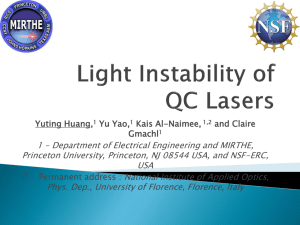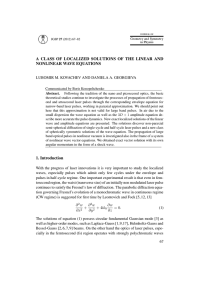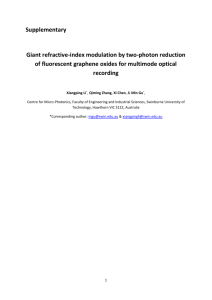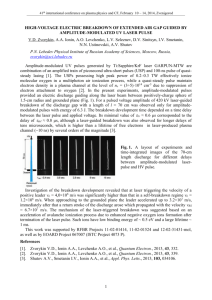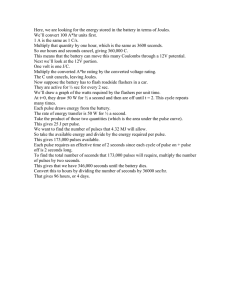Space-time focusing of phase-stabilized nanojoule-level
advertisement
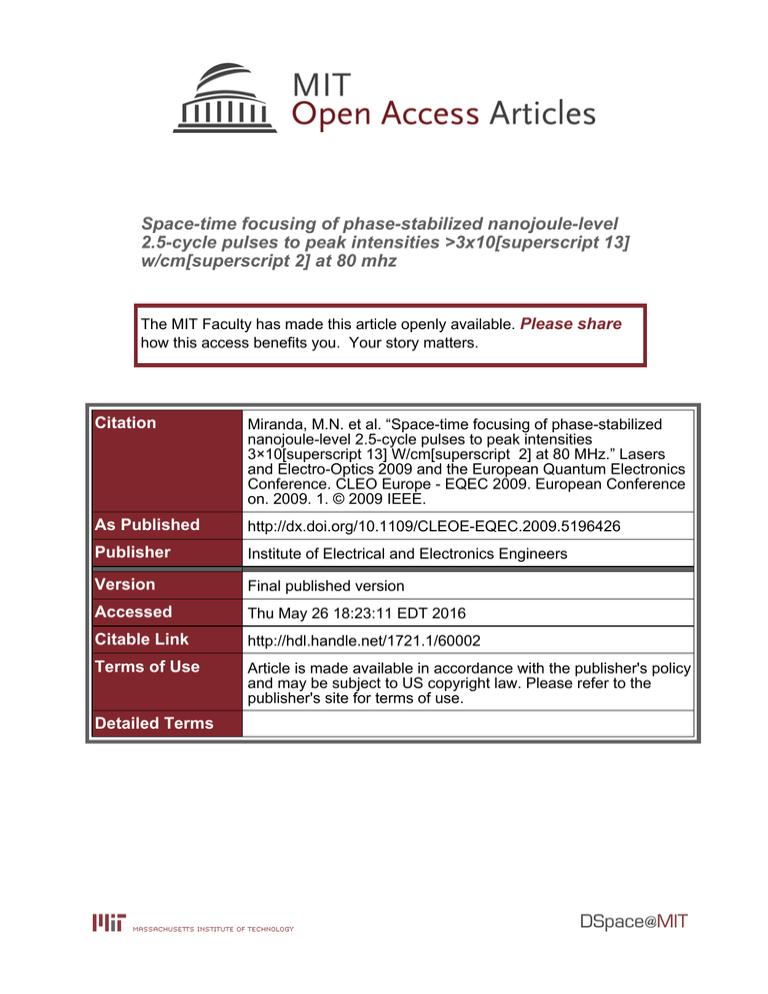
Space-time focusing of phase-stabilized nanojoule-level 2.5-cycle pulses to peak intensities >3x10[superscript 13] w/cm[superscript 2] at 80 mhz The MIT Faculty has made this article openly available. Please share how this access benefits you. Your story matters. Citation Miranda, M.N. et al. “Space-time focusing of phase-stabilized nanojoule-level 2.5-cycle pulses to peak intensities 3×10[superscript 13] W/cm[superscript 2] at 80 MHz.” Lasers and Electro-Optics 2009 and the European Quantum Electronics Conference. CLEO Europe - EQEC 2009. European Conference on. 2009. 1. © 2009 IEEE. As Published http://dx.doi.org/10.1109/CLEOE-EQEC.2009.5196426 Publisher Institute of Electrical and Electronics Engineers Version Final published version Accessed Thu May 26 18:23:11 EDT 2016 Citable Link http://hdl.handle.net/1721.1/60002 Terms of Use Article is made available in accordance with the publisher's policy and may be subject to US copyright law. Please refer to the publisher's site for terms of use. Detailed Terms Space-time focusing of phase-stabilized nanojoule-level 2.5-cycle pulses to peak intensities >3× ×1013 W/cm2 at 80 MHz Miguel N. Miranda1, Pedro B. Oliveira1, L. M. Bernardo1, Franz X. Kärtner2, Helder M. Crespo1 1. IFIMUP and IN - Institute of Nanoscience and Nanotechnology, Departamento de Física, Faculdade de Ciências, Universidade do Porto, Rua do Campo Alegre, 687, 4169-007 Porto, Portugal. 2. Department of Electrical Engineering and Computer Science and Research Laboratory of Electronics, Massachusetts Institute of Technology, Cambridge, Massachusetts 02139-430, USA. Tight focusing of laser light down to near diffraction limited spot sizes can be easily achieved with high numerical aperture microscope objectives, and state-of-the-art ultrafast laser technology has made possible the generation of sub-two-cycle pulses directly from laser oscillators [1, 2]. In applications such as OCT, the spot size translates into lateral resolution, while techniques relying on nonlinear optical effects, such as CARS spectroscopy and two-photon microscopy, rely on both the spatial and temporal confinement of radiation, which leads to high peak intensities. Space-time focusing of carrier-envelope phase stabilized few-cycle laser pulses plays a crucial role in the study of phase-dependent nonlinear optical phenomena [3]. However, such focusing is not easily achieved, mostly due to the very broad bandwidths of few-cycle pulses and the dispersion introduced by the large amounts of glass present in high-quality microscope objectives. Non-dispersive reflective objectives have been used for this purpose [3], but their intrinsic obscuration usually limits the coupling efficiency to less than 10%, with a consequent decrease in peak intensity. Dispersion compensation of microscope objectives using chirped mirrors has resulted in sub-14-fs pulses [4], and very recently, sub-8-fs pulses were obtained with a 4-f pulse shaper arrangement based on a mechanically deformable mirror [5]. In this work we demonstrate the efficient focusing of 2.5-cycle laser pulses from a phase-stabilized broadband laser oscillator with a repetition rate of 80 MHz (Femtolasers Rainbow) using a simple and compact setup based on octave-spanning double-chirped mirrors [6] to pre-compensate the dispersion of microscope objectives. The beam diameter was kept at <2 mm at the entrance of the objectives in order to minimize undesirable radius-depend group-delay dispersion effects [7]. Temporal characterization was performed with a modified SHG interferometric autocorrelator capable of measuring the pulse duration directly at the focus of the objectives, and the spot size was measured by imaging it with another microscope objective and CCD camera. For an input pulse energy of 2.5 nJ, a 63× microscope objective (N.A.= 0.85) resulted in clean 6.8 fs (FWHM) pulses with spot sizes as small as 1.1 µm (FWHM), as shown in Fig. 1. Fig. 1 Measured focused pulses obtained with a 63× microscope objective (N.A. = 0.85): (left) Interferometric and intensity autocorrelations at the focus (inset: intensity spectrum). The retrieved pulse width assuming a sech2 shape is 6.8 fs FWHM. (right) Beam intensity profile at the focus, with x-cut slice inset. The beam diameter is 1.1 µm FWHM. Thin glass slides were used to fine tune the dispersion and optimize the final pulse width. The overall system efficiency is >95%, corresponding to a peak intensity >3.7×1013 W/cm2, already at the onset of extreme phasedependent nonlinear effects such as high-harmonic generation (HHG). To our knowledge, these are the highest peak intensities and shortest pulse durations ever obtained for focused low-energy phase-stabilized pulses at multi-MHz repetition rates, which should have an impact on a number of applications. The estimated peak intensities open the possibility of studying phase-dependent extreme nonlinear optical phenomena such as HHG directly with a few-cycle laser oscillator at MHz repetition rates. References [1] F. X. Kärtner et al., “Few-Cycle Pulses Directly from a Laser”, in “Few-Cycle Laser Pulse Generation and Its Applications,” pp. 73-136 (Springer, 2004). [2] H. M. Crespo et al., Opt. Lett. 33, 833-835 (2008). [3] O. D. Mücke et al., Phys. Rev. Lett. 85, 057401 (2001). [4] G. Tempea et al., “Dispersion Management for Microscope Objectives”, CLEO (OSA, 2005), paper CThBB6. [5] Y. Ozeki et al., Opt. Express 16, 2778 (2008). [6] F. X. Kärtner et al., J. Opt. Soc. Am. B 18, 882-885 (2001). [7] J. Jasapara and W. Rudolph, Opt. Lett. 24, 777 (1999). c 978-1-4244-4080-1/09/$25.00 2009 IEEE
